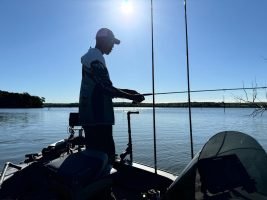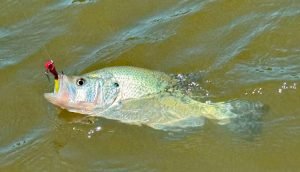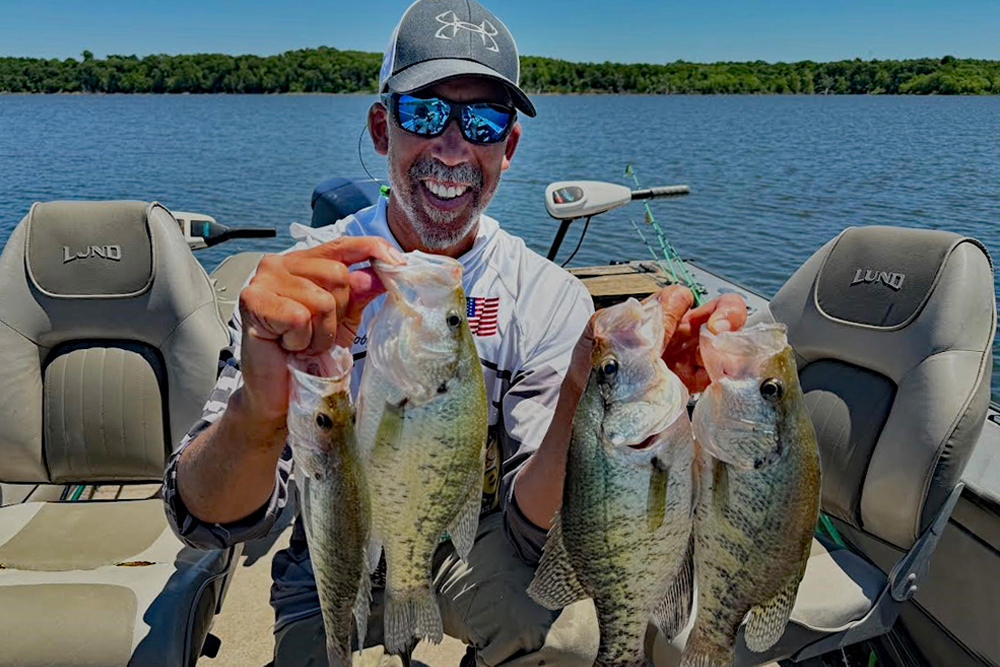Toby Leavendusky was all smiles after using his forward-facing sonar to catch some
big crappies during a summer trip to Hillsdale Lake in northeast Kansas. (Photo: Brent Frazee)
Kansas Crappie Fishing Treasure
by Brent Frazee
Think of the state of Kansas and most folks envision massive rolling fields of wheat – a dry state where most sportsmen pursue ring-neck pheasants or big bucks. It rarely shows up on most crappie-fishing radars.
Last month we shared a south-central Kansas crappie hotspot. This month we learn how Toby Leavendusky is doing his part to put Kansas on the crappie-fishing map. Leavendusky, runs Absolute Fishing Guides in northeast Kansas, mostly fishing on Hillsdale Lake just about 30 minutes outside of Kansas City.
Leavendusky has been around long enough that he remembers how crappie fishing was before the modern electronics age. Fishing reservoirs in Kansas, he would begin off-shore and gradually work his way in toward shallower water. When he would snag flooded timber or brush, he would throw out a marker buoy and fish that cover. More often than not, that simple approach would produce big stringers of fish.
“It was old-school, but it worked. It forced me to learn about habits of the species I was trying to catch,” he said.

Leavendusky admits he is still learning, but nowadays he is using a decidedly different – and more efficient – tool. Like many crappie fishermen these days, he spends much of his day on the water staring at the screen of a Garmin Livescope, revealing real-time movement of the fish below.
Unlike the past, it is no longer a mystery as to whether there are schools of fish lurking below. But contrary to what some opponents of the advanced electronics claim, it’s no guarantee that fish will be caught.
“To be successful, you still have to possess a knowledge of the crappies’ behavior by season, and what it takes to get them to hit,” Leavendusky said.
He considers three major factors: the color, the profile and the size of the bait.
“That’s the beauty of (forward-facing sonar),” Leavendusky said. “I can see how the crappies react to my jigs. If they show any interest at all but they don’t hit, I’ll go from there. I’ll make adjustments, like in the color or the size of the bait. Sometimes, that’s all it takes.”
That was the case on an early-summer trip to in northeastern Kansas. As he fished a flat, he could see crappies on his Livescope screen approach the plastic jigs he dropped in front of them, but they never finished the deal.
He decided to change colors from the shad blue color that had been working on previous trips to a rusty-orange bait with a chartreuse tail.
Instant success. A 12-inch crappie hit the new bait on Leavendusky’s first drop, and several others were caught in short order.
“I absolutely believe color can make a difference,” he said. “I’ve seen times when they get used to one color, then they just stop hitting. (Forward-facing sonar) shows they’re still there, but maybe I need to give them another color. A lot of times, that makes all the difference in the world.”
Leavendusky doesn’t have to search too long for color combinations the fish haven’t seen before. He pours his own plastic jigs.
He started during the COVID years when jigs became harder to find on store shelves. He experimented with different color combinations, even adding glitter to the mix, then would take them out to a nearby reservoir to test them.
After those test runs provided immediate results, Leavendusky upped his game. He went from two molds to 20 and he continued to make jigs to meet most conditions.

He doesn’t sell his baits. As a nurse and a guide, he doesn’t have enough time to keep up with the demand of mass-producing homemade jigs. He just pours the jigs for the use of his guide clients and he is pleased with the way that has worked out.
But Leavendusky doesn’t try to force-feed the crappies to eat his baits. If he hits a couple places in one arm of the lake and the fish aren’t eating, he will head for another arm in hopes finding more cooperative fish.
“I guarantee they are biting somewhere on that lake,” he said. “It’s your job to find the active fish.”
Leavendusky tries to match the size and profile of the bait the crappies are feeding on. He will start big and downsize if the fish aren’t hitting. If the fish still aren’t hitting, he will even go to small jigging spoons.
“Sometimes, they just want that flash,” he said.
Whatever the bait, his presentation remains consistent.
Leavendusky will lower his lure to just above the fish he marks on his Garmin Livescope. If the crappie shows an interest, he will slowly raise his jig to give the impression that a shad is trying to escape its predator.
That often triggers a strike.
He is careful not to drop the jig on top of the fish or below it. That often alarms the crappie and ruins his chances of catching it.
GOING WITHOUT THE FFS
Leavendusky catches fish year-round with forward-facing sonar. But that doesn’t mean he won’t use other methods.

He likes to troll small crankbaits or spider-rig when the fish are scattered and roaming – techniques that are more about just “covering water” than about pinpointing fish.
But most of the time, Leavendusky is fishing vertically, looking at the schools of fish below. His favorite time to fish is winter.
“Anytime the water temperature is below 38 degrees, it’s going to be good,” Leavendusky said. “They’re usually schooled up on trees, and they’re super easy to catch.”
Unlike most crappie fishermen, his least-favorite time is spring.
“During the spawn, there are just too many variables,” he said. “You’re trying to figure out what banks they’re on. And weather changes can bring them in and send them out.”
Despite those challenges, Leavendusky knows he guides in the right place. He lives near Topeka, Kansas, and is surrounded by good crappie waters –Perry, Clinton, Melvern, Pomona, and Milford.
“I don’t need to travel very far to find good crappie fishing,” said. “We have some great opportunities in this part of the state.”
Brent Frazee is an award-winning writer and photographer who lives in a suburb of Kansas City, Mo. He was the outdoors editor for The Kansas City Star for 36 years


